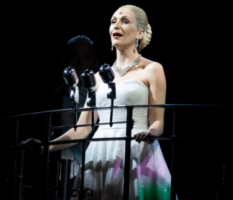
DPA enhances Evita's Turin production
PSNEurope explores how DPA Microphones helped an unusual production of Evita hit the high notes in Turin…
Staging a well-known musical with a long history in a beautiful opera space that is normally only used for acoustic music is a massive undertaking for any sound team, but when the musical in question is Andrew Lloyd Webber/Tim Rice’s Evita and the opera space is the Teatro Regio Torino in Turin, expectations are bound to be high.
This was the task faced by production company Bill Kenright Ltd (in agreement with The Really Useful Group) when it was invited by Teatro Regio Torino to stage eight live performances of Evita and to merge the Opera’s orchestra with amplified electric instruments more commonly used for musical productions.
“We wanted the Teatro Regio Torino orchestra to combine with the production from our London show so that they ‘melted’ together to create a natural uniformed sound,” says sound designer Dan Samson, who has worked with many large scale touring theatre shows including Jesus Christ Superstar and The Sound Of Music. “Before I started specifying equipment for the production I sat down with musical supervisor David Steadman and musical producer Gary Hickson and between us we created the concept. The first question we asked was, Are we going to mic the orchestra? And the answer was a resounding yes. The cast and the UK band have always been amplified, with almost 100% DPA microphones, so the natural choice was to mic the orchestra with DPAs as well.”
For those who don’t know, Evita centres on the life of Argentine political leader Eva Perón, the second wife of the country’s president Juan Perón. The story follows Evita’s early life, rise to power, charity work and eventual death. A total of eight performances were staged in the 1,600-seat theatre. Each was a sellout.
DPA microphones were used “everywhere” across the production, Samson says. The orchestra pit alone was covered by 80 d:dicate microphones, while the cast were amplified by more than 30 d:screet 4061 CORE Omnidirectional Miniature Microphones worn as lavaliers. Indeed, so many DPAs were required that rental company Stage Sound Services, which equipped the production, needed the support of DPA’s UK distributor Sound Network to make up the numbers.
Hickson says that Samson was undoubtedly the man to deliver the compact, singular sound he was looking for in Turin.
“We both understood what was needed for a production of this caliber and, through communication with Evita production director Tom de Keyser and Phil Hurley of Stage Sound Services, we were able to get the required equipment, including more than 160 DPA microphones,” he explains. “We are very fortunate to have reached a level where producers and production companies hear the difference in the sound quality when it’s done right. The audience then get an audible experience as well as a visual one, which together with all the talent onstage makes the show perfect.”
Capturing the natural sound of the orchestra was
a key criterion for the sound team, as was building a bridge between the sound department and the orchestra.
“It might seem natural for both parties to communicate all the time, but in reality, this is rarely the case,” Samson comments. “We are changing this, little by little.”
He adds that it was evident to him that all the equipment used, including the microphones, had to be as transparent as possible because no plugin could bring out natural sound if it wasn’t picked up correctly at source. To this end he used a mixture of d:dicate 4006A Omni, 4011A and 2011C Cardioid microphones, which were placed in the orchestra pit with help from Operator Piers Archer who mixed the shows and is tasked with recreating the sound design nightly.
“In the pit, size really matters, so I used d:dicate 4011C mics on all the strings and flutes because the C preamp has a smaller profile,” Samson explains. “d:dicate 2011Cs were chosen for the woodwinds, percussion, conga and bongo, and d:dicate 4006C were used on the timpani. We decided not to use clip-ons like the d:vote 4099 because I didn’t want to frighten the orchestra too much. They are not familiar with being amplified so having any microphones around was new territory for them.”
He adds that on a standard production of Evita, where there are nine musicians, microphones are only used on drums, percussion, trumpet, trombone, accordion and acoustic guitar. Deploying 80 microphones to amplify an entire orchestra with 34 strings, nine woodwinds, nine brass players and two percussionists – not to mention the microphones used by the cast – resulted in a much bigger number of channels to deal with.
“Usually we have one Digico SD7t, but for this production we added a Digico SD10t console just for the orchestra,” he says. “The cast was mic-ed exactly how we always mic them, but because of the layout of the theatre we were only able to place the PA speakers behind the pit. This meant that the line arrays were facing the pit. I chose d&b Y Series speakers and designed the array to beam over the pit, but we were still focusing a lot on the angles of the microphones so that they were not pointing directly to the PA.”
DPA d:screet 4061 lavalier mics were chosen for the cast. “Speech intelligibility is the most important factor in a musical. The songs are good, and the music sounds beautiful but if you can’t hear the words, there is no point in going to the opera,” Samson says. “What I like about d:screet 4061s is the fact that they are consistent, which makes it easy for Piers to mix between actors. We mix ‘line by line’, with every line mixed by hand. We use very little compression as it is my philosophy that no machine can hear what we hear, and if you take away the human touch and ear, you lose the intelligibility. It is all about gain structure and microphone placement – having the right mic for the right job. If it doesn’t sound right, I know that either the mic characteristic is wrong, or the mic placement is wrong, and either way I’d prefer to fix it at the sound source rather than touching the EQ.”
After completing its run in Turin, Bill Kenright Ltd’s production of Evita spent the summer touring Europe, although this time without the orchestra. It is now back in the UK and will complete its run at the end of 2018.
“The Turin shows were certainly a highlight and represented the most DPA microphones I have ever used on a show, and I’m going to use even more in the future,” Samson concludes. “I very rarely look for a microphone solution that isn’t DPA because I have so much confidence in the brand. I’ve even had the courage to test new types of mics live, because I trust that DPA will not let me down and ask me to use something that is not perfectly OK. Take the new CORE by DPA mics as an example – they are great and I’m using them whenever I can get my hands on them.”
Source: mi-pro.co.uk









